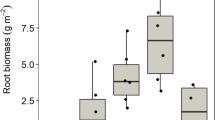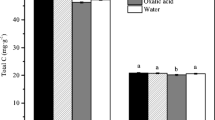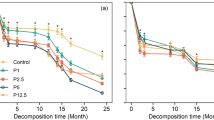Abstract
Background and aims
Root exudation can prime microbial synthesis of additional exoenzymes and consequently accelerate organic carbon (C) and nitrogen (N) mineralization. Such exudate induced priming effect (EPE) has been hypothesized to depend on exudate rate and stoichiometry. Little is known about how EPE would affect litter decomposition. We employed a microcosm experiment to evaluate the influence of root exudate on litter nutrient release and microbial enzyme functions.
Methods
Leaf litters of Pinus massoniana, Quercus variabilis and Robinia pseudoacacia were incubated under two soil conditions (fertile versus barren). Solutions of chemicals often found in root exudates with contrasting C:N ratios were inoculated frequently into the microcosms to simulate exudation. By comparing with a water control, exudate effect was determined.
Results
In barren soils, exudates with C:N ratio of 10 significantly decelerated C loss of R. pseudoacacia, all N-containing exudates significantly enhanced the N-cycling related enzymes in decomposing Q. variabilis, while C-only exudate accelerated N loss of P. massoniana. In fertile soils, C-only exudate promoted the N-cycling related enzymes in decomposing R. pseudoacacia.
Conclusions
A stoichiometric C:N constraint on microbial utilization of exudates arose in decomposing recalcitrant litters in barren soil. EPE and its stoichiometric constraint depend on interactions with litter quality and soil condition. The findings arouse the consequences of exudate rate and stoichiometry changes in determining soil nutrient balance.




Similar content being viewed by others
References
Allison SD, Weintraub MN, Gartner TB, Waldrop MP (2011) Evolutionary-economic principles as regulators of soil enzyme production and ecosystem function. In: Shukla G, Varma A (eds) Soil enzymology. Springer, Berlin, Heidelberg, pp 229–243
Anderson MJ (2001) A new method for non-parametric multivariate analysis of variance. Austral Ecol 26:32–46
Badri DV, Vivanco JM (2009) Regulation and function of root exudates. Plant Cell Environ 32:666–681
Baetz U, Martinoia E (2014) Root exudates: the hidden part of plant defense. Trends Plant Sci 19:90–98
Bell C, Carrillo Y, Boot CM, Rocca JD, Pendall E, Wallenstein MD (2014) Rhizosphere stoichiometry: are C : N : P ratios of plants, soils, and enzymes conserved at the plant species-level. New Phytol 201:505–517
Bengtson P, Barker J, Grayston SJ (2012) Evidence of a strong coupling between root exudation, C and N availability, and stimulated SOM decomposition caused by rhizosphere priming effects. Ecol Evol 2:1843–1852
Bertin C, Yang XH, Weston LA (2003) The role of root exudates and allelochemicals in the rhizosphere. Plant Soil 256:67–83
Blagodatskaya E, Kuzyakov Y (2008) Mechanisms of real and apparent priming effects and their dependence on soil microbial biomass and community structure: critical review. Biol Fertil Soils 45:115–131
Blagodatskaya E, Kuzyakov Y (2013) Active microorganisms in soil: critical review of estimation criteria and approaches. Soil Biol Biochem 67:192–211
Bonanomi G, Cesarano G, Gaglione SA, Ippolito F, Sarker T, Rao MA (2017) Soil fertility promotes decomposition rate of nutrient poor, but not nutrient rich litter through nitrogen transfer. Plant Soil 412:397–411
Bowen GD (1969) Nutrient status effects on loss of amides and amino acids from pine roots. Plant Soil 30:139–142
Bradford MA, Fierer N, Reynolds JF (2008) Soil carbon stocks in experimental mesocosms are dependent on the rate of labile carbon, nitrogen and phosphorus inputs to soils. Funct Ecol 22:964–974
Burns RG, DeForest JL, Marxsen J, Sinsabaugh RL, Stromberger ME, Wallenstein MD, Weintraub MN, Zoppini A (2013) Soil enzymes in a changing environment: current knowledge and future directions. Soil Biol Biochem 58:216–234
Caldwell BA (2005) Enzyme activities as a component of soil biodiversity: a review. Pedobiologia 49:637–644
Canarini A, Kaiser C, Merchant A, Richter A, Wanek W (2019) Root exudation of primary metabolites: mechanisms and their roles in plant responses to environmental stimuli. Front Plant Sci 10:157
Carreiro MM, Sinsabaugh RL, Repert DA, Parkhurst DF (2000) Microbial enzyme shifts explain litter decay responses to simulated nitrogen deposition. Ecology 81:2359–2365
Chen RR, Senbayram M, Blagodatsky S, Myachina O, Dittert K, Lin XG, Blagodatskaya E, Kuzyakov Y (2014) Soil C and N availability determine the priming effect: microbial N mining and stoichiometric decomposition theories. Glob Chang Biol 20:2356–2367
Cheng W (2009) Rhizosphere priming effect: its functional relationships with microbial turnover, evapotranspiration, and C-N budgets. Soil Biol Biochem 41:1795–1801
Cheng W, Johnson DW (1998) Elevated CO2, rhizosphere processes, and soil organic matter decomposition. Plant Soil 202:167–174
Cheng W, Parton WJ, Gonzalez-Meler MA, Phillips R, Asao S, McNickle GG, Brzostek E, Jastrow JD (2014) Synthesis and modeling perspectives of rhizosphere priming. New Phytol 201:31–44
Cornwell WK, Cornelissen JHC, Amatangelo K, Dorrepaal E, Eviner VT, Godoy O, Hobbie SE, Hoorens B, Kurokawa H, Perez-Harguindeguy N, Quested HM, Santiago LS, Wardle DA, Wright IJ, Aerts R, Allison SD, van Bodegom P, Brovkin V, Chatain A, Callaghan TV, Diaz S, Garnier E, Gurvich DE, Kazakou E, Klein JA, Read J, Reich PB, Soudzilovskaia NA, Vaieretti MV, Westoby M (2008) Plant species traits are the predominant control on litter decomposition rates within biomes worldwide. Ecol Lett 11:1065–1071
Craine JM, Morrow C, Fierer N (2007) Microbial nitrogen limitation increases decomposition. Ecology 88:2105–2113
De Nobili M, Contin M, Mondini C, Brookes PC (2001) Soil microbial biomass is triggered into activity by trace amounts of substrate. Soil Biol Biochem 33:1163–1170
Dijkstra FA, Carrillo Y, Pendall E, Morgan JA (2013) Rhizosphere priming: a nutrient perspective. Front Microbiol 4:216
Dorodnikov M, Blagodatskaya E, Blagodatsky S, Marhan S, Fangmeier A, Kuzyakov Y (2009) Stimulation of microbial extracellular enzyme activities by elevated CO2 depends on soil aggregate size. Glob Chang Biol 15:1603–1614
Drake JE, Darby BA, Giasson MA, Kramer MA, Phillips RP, Finzi AC (2013) Stoichiometry constrains microbial response to root exudation-insights from a model and a field experiment in a temperate forest. Biogeosciences 10:821–838
Fanin N, Fromin N, Buatois B, Hättenschwiler S (2013) An experimental test of the hypothesis of non-homeostatic consumer stoichiometry in a plant litter-microbe system. Ecol Lett 16:764–772
Fanin N, Fromin N, Bertrand I (2016) Functional breadth and home-field advantage generate functional differences among soil microbial decomposers. Ecology 97:1023–1037
Finzi AC, Abramoff RZ, Spiller KS, Brzostek ER, Darby BA, Kramer MA, Phillips RP (2015) Rhizosphere processes are quantitatively important components of terrestrial carbon and nutrient cycles. Glob Chang Biol 21:2082–2094
Fontaine S, Henault C, Aamor A, Bdioui N, Bloor JMG, Maire V, Mary B, Revaillot S, Maron PA (2011) Fungi mediate long term sequestration of carbon and nitrogen in soil through their priming effect. Soil Biol Biochem 43:86–96
Freschet GT, Aerts R, Cornelissen JHC (2012) A plant economics spectrum of litter decomposability. Funct Ecol 26:56–65
Frey SD, Knorr M, Parrent JL, Simpson RT (2004) Chronic nitrogen enrichment affects the structure and function of the soil microbial community in temperate hardwood and pine forests. For Ecol Manag 196:159–171
Frost PC, Benstead JP, Cross WF, Hillebrand H, Larson JH, Xenopoulos MA, Yoshida T (2006) Threshold elemental ratios of carbon and phosphorus in aquatic consumers. Ecol Lett 9:774–779
Gholz HL, Wedin DA, Smitherman SM, Harmon ME, Parton WJ (2000) Long-term dynamics of pine and hardwood litter in contrasting environments: toward a global model of decomposition. Glob Chang Biol 6:751–765
Guyonnet JP, Vautrin F, Meiffren G, Labois C, Cantarel AAM, Michalet S, Comte G, Haichar FZ (2017) The effects of plant nutritional strategy on soil microbial denitrification activity through rhizosphere primary metabolites. FEMS Microbiol Ecol 93:fix022
Haichar FZ, Santaella C, Heulin T, Achouak W (2014) Root exudates mediated interactions belowground. Soil Biol Biochem 77:69–80
Hall EK, Maixner F, Franklin O, Daims H, Richter A, Battin T (2011) Linking microbial and ecosystem ecology using ecological stoichiometry: a synthesis of conceptual and empirical approaches. Ecosystems 14:261–273
Hamer U, Marschner B (2005) Priming effects in different soil types induced by fructose, alanine, oxalic acid and catechol additions. Soil Biol Biochem 37:445–454
He ZL, Xiong JB, Kent AD, Deng Y, Xue K, Wang GJ, Wu LY, Van Nostrand JD, Zhou JZ (2014) Distinct responses of soil microbial communities to elevated CO2 and O3 in a soybean agro-ecosystem. ISME J 8:714–726
Hessen DO, Agren GI, Anderson TR, Elser JJ, De Ruiter PC (2004) Carbon, sequestration in ecosystems: the role of stoichiometry. Ecology 85:1179–1192
Hobbie SE, Reich PB, Oleksyn J, Ogdahl M, Zytkowiak R, Hale C, Karolewski P (2006) Tree species effects on decomposition and forest floor dynamics in a common garden. Ecology 87:2288–2297
Hopkins F, Gonzalez-Meler MA, Flower CE, Lynch DJ, Czimczik C, Tang JW, Subke JA (2013) Ecosystem-level controls on root-rhizosphere respiration. New Phytol 199:339–351
Hu L, Robert CAM, Cadot S, Zhang X, Ye M, Li B, Manzo D, Chervet N, Steinger T, van der Heijden MGA, Schlaeppi K, Erb M (2018) Root exudate metabolites drive plant-soil feedbacks on growth and defense by shaping the rhizosphere microbiota. Nat Commun 9:2738
Jones DL, Nguyen C, Finlay RD (2009) Carbon flow in the rhizosphere: carbon trading at the soil-root interface. Plant Soil 321:5–33
Keiser AD, Keiser DA, Strickland MS, Bradford MA (2014) Disentangling the mechanisms underlying functional differences among decomposer communities. J Ecol 102:603–609
Koenker R (2012) quantreg: Quantile regression in R. R package version 5.5. https://CRAN.R-project.org/package=quantreg. Accessed 7 Jan 2016
Kuzyakov Y (2010) Priming effects: interactions between living and dead organic matter. Soil Biol Biochem 42:1363–1371
Langley JA, McKinley DC, Wolf AA, Hungate BA, Drake BG, Megonigal JP (2009) Priming depletes soil carbon and releases nitrogen in a scrub-oak ecosystem exposed to elevated CO2. Soil Biol Biochem 41:54–60
Manzoni S, Porporato A (2009) Soil carbon and nitrogen mineralization: theory and models across scales. Soil Biol Biochem 41:1355–1379
Manzoni S, Taylor P, Richter A, Porporato A, Agren GI (2012) Environmental and stoichiometric controls on microbial carbon-use efficiency in soils. New Phytol 196:79–91
Martiny JBH, Bohannan BJM, Brown JH, Colwell RK, Fuhrman JA, Green JL, Horner-Devine MC, Kane M, Krumins JA, Kuske CR, Morin PJ, Naeem S, Ovreas L, Reysenbach AL, Smith VH, Staley JT (2006) Microbial biogeography: putting microorganisms on the map. Nat Rev Microbiol 4:102–112
Nottingham AT, Turner BL, Winter K, Chamberlain PM, Stott A, Tanner EVJ (2013) Root and arbuscular mycorrhizal mycelial interactions with soil microorganisms in lowland tropical forest. FEMS Microbiol Ecol 85:37–50
Oksanen J, Blanchet FG, Kindt R, Legendre P, Minchin PR, O’Hara RB, Simpson GL, Solymos P, Stevens MHH, Wagner H (2015) vegan: Community ecology package. R package version 20.10. http://CRAN.R-project.org/package=vegan. Accessed 7 Jan 2016
Olson JS (1963) Energy storage and the balance of producers and decomposers in ecological systems. Ecology 44:322–331
Osono T, Takeda H (2002) Comparison of litter decomposing ability among diverse fungi in a cool temperate deciduous forest in Japan. Mycologia 94:421–427
Parton W, Silver WL, Burke IC, Grassens L, Harmon ME, Currie WS, King JY, Adair EC, Brandt LA, Hart SC, Fasth B (2007) Global-scale similarities in nitrogen release patterns during long-term decomposition. Science 315:361–364
Phillips RP, Finzi AC, Bernhardt ES (2011) Enhanced root exudation induces microbial feedbacks to N cycling in a pine forest under long-term CO2 umigation. Ecol Lett 14:187–194
Phillips RP, Meier IC, Bernhardt ES, Grandy AS, Wickings K, Finzi AC (2012) Roots and fungi accelerate carbon and nitrogen cycling in forests exposed to elevated CO2. Ecol Lett 15:1042–1049
Purahong W, Schloter M, Pecyna MJ, Kapturska D, Daumlich V, Mital S, Buscot F, Hofrichter M, Gutknecht JLM, Kruger D (2014) Uncoupling of microbial community structure and function in decomposing litter across beech forest ecosystems in Central Europe. Sci Rep 4:7014
R Development Core Team (2015) R: a language and environment for statistical computing. R version 3.2.3. R Foundation for Statistical Computing, Vienna. http://CRAN.R-project.org/. Accessed 7 Jan 2016
Ross DJ, Grayston SJ, Whitehead D (2006) Changes in soil carbon and nitrogen properties and microbial communities in relation to growth of Pinus radiata and Nothofagus fusca trees after 6 years at ambient and elevated atmospheric CO2. Glob Chang Biol 12:1690–1706
Rousk K, Michelsen A, Rousk J (2016) Microbial control of soil organic matter mineralization responses to labile carbon in subarctic climate change treatments. Glob Chang Biol 22:4150–4161
Rovira AD (1969) Plant root exudates. Bot Rev 35:35–57
Sanchez-Carrillo S, Alvarez-Cobelas M, Angeler DG, Serrno-Grijalva L, Sanchez- Andres R, Cirujano S, Schmid T (2018) Elevated atmospheric CO2 increases root exudation of carbon in wetlands: results from the first free-air CO2 enrichment facility (FACE) in a marshland. Ecosystems 21:852–867
Sayer EJ, Tanner EVJ, Cheesman AW (2006) Increased litterfall changes fine root distribution in a moist tropical forest. Plant Soil 281:5–13
Schimel DS (1995) Terrestrial ecosystems and the carbon-cycle. Glob Chang Biol 1:77–91
Schimel JP, Weintraub MN (2003) The implications of exoenzyme activity on microbial carbon and nitrogen limitation in soil: a theoretical model. Soil Biol Biochem 35:549–563
Sinsabaugh RL, Moorhead DL (1994) Resource-allocation to extracellular enzyme-production - a model for nitrogen and phosphorus control of litter decomposition. Soil Biol Biochem 26:1305–1311
Smith WH (1976) Character and significance of forest tree root exudates. Ecology 57:324–331
Staddon PL, Reinsch S, Olsson PA, Ambus P, Luscher A, Jakobsen I (2014) A decade of free-air CO2 enrichment increased the carbon throughput in a grass-clover ecosystem but did not drastically change carbon allocation patterns. Funct Ecol 28:538–545
Sterner RW, Elser JJ (2002) Ecological stoichiometry: the biology of elements from molecules to the biosphere. Princeton University Press
Subke JA, Hahn V, Battipaglia G, Linder S, Buchmann N, Cotrufo MF (2004) Feedback interactions between needle litter decomposition and rhizosphere activity. Oecologia 139:551–559
Swift MJ, Heal OW, Anderson JM (1979) Decomposition in terrestrial ecosystems. Univ of California Press
van der Wal A, Geydan TD, Kuyper TW, de Boer W (2013) A thready affair: linking fungal diversity and community dynamics to terrestrial decomposition processes. FEMS Microbiol Rev 37:477–494
von Stockar U, Maskow T, Liu JS, Marison IW, Patino R (2006) Thermodynamics of microbial growth and metabolism: an analysis of the current situation. J Biotechnol 121:517–533
Wang FC, Fang XM, Ding ZQ, Wan SZ, Chen FS (2016) Effects of understory plant root growth into the litter layer on the leaf litter decomposition of two woody species in a subtropical forest. For Ecol Manag 364:39–45
Wickings K, Grandy AS, Reed SC, Cleveland CC (2012) The origin of litter chemical complexity during decomposition. Ecol Lett 15:1180–1188
Acknowledgements
We thank Elizabeth Tokarz at the Yale University for her assistance with English language and grammatical editing of this manuscript. This work was supported by the National Key Research and Development Program of the Ministry of Science and Technology of China (No. 2016YFD0600204); the State Key Program of National Natural Science Foundation of China (No. 31530007); the Sanxin Forestry Project in Jiangsu Province (No. LYSX[2016]46); the specimen platform of China and the teaching specimens sub-platform (2005DKA21403-JK); the specimen platform of China, and the teaching specimens sub-platform (2005DKA21400); the Water Conservancy Science and Technology Project of Jiangsu Province (2018063); and the National Natural Science Foundation of China (31870598).
Author information
Authors and Affiliations
Corresponding author
Additional information
Responsible Editor: Zucong Cai.
Publisher’s note
Springer Nature remains neutral with regard to jurisdictional claims in published maps and institutional affiliations.
Electronic supplementary material
ESM 1
(DOCX 562 kb)
Rights and permissions
About this article
Cite this article
Tian, K., Kong, X., Yuan, L. et al. Priming effect of litter mineralization: the role of root exudate depends on its interactions with litter quality and soil condition. Plant Soil 440, 457–471 (2019). https://doi.org/10.1007/s11104-019-04070-5
Received:
Accepted:
Published:
Issue Date:
DOI: https://doi.org/10.1007/s11104-019-04070-5




